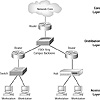
FIGURE 1.6 The two-tier model
| Previous | Table of Contents | Next |
The partial-mesh model does not constrain the designer with a predefined number of circuits per nodes in the network, which permits some latitude in locating and provisioning circuits. However, this flexibility can cause reliability and performance problems. The benefit is cost—fewer circuits can support the entire enterprise while providing specific data paths for higher priority connections.
The two-tier model shares many attributes with the partial-mesh model, but the design has some additional benefits. This design typically evolves from the merger of two companies—each of small size and using historical star topologies. However, the design may also merit use in the initial deployment of a medium-sized network. Figure 1.6 illustrates the two-tier model. This model is sometimes used in metropolitan settings where a number of buildings require connectivity but only two buildings have WAN connections—this design reduces total costs yet provides some redundancy. The two core installations in Figure 1.6 would incorporate the WAN links.
Notice that the two-tier model introduces a single, significant point of failure: the link between the primary locations. However, if designed for each side (east/west) to be independent of the other, the model can work effectively.
This solution works best when both locations have strong support organizations and the expenses associated with complete integration are high. Because of the limited connectivity between the two primary sites and the lack of any other connections, this solution typically provides the lowest cost and is the simplest approach. When a single core location is selected, the alternate primary location can move to the distribution layer (explained in the next section) or can provide a distributed core for redundancy.

FIGURE 1.6 The two-tier model
Most modern networks are designed around a form of the three-tier model. As shown in Figure 1.7, this network model defines three levels (functions) of the network: core, distribution, and access. The highest level is the network core, which interconnects the distribution layer resources. Access routers connect to the distribution layer moving up the model and to workstations and other resources moving down the model.
This design affords a number of advantages, although the costs are greater than those for the previous models. The biggest advantage to this design is scalability.

FIGURE 1.7 The three-tier model
Virtually all scalable networks follow the three-tier model for network design. This model is particularly valuable when using hierarchical routing protocols and summarization, specifically OSPF, but it is also helpful in reducing the impact of failures and changes in the network. The design also simplifies implementation and troubleshooting, in addition to contributing to predictability and manageability. These benefits greatly augment the functionality of the network and the appropriateness of the model to address network design goals. These benefits, which are typically incorporated in hierarchical designs, are either not found inherently in the other models or not as easily included in them. Following is a closer look at the benefits just mentioned:
| Previous | Table of Contents | Next |